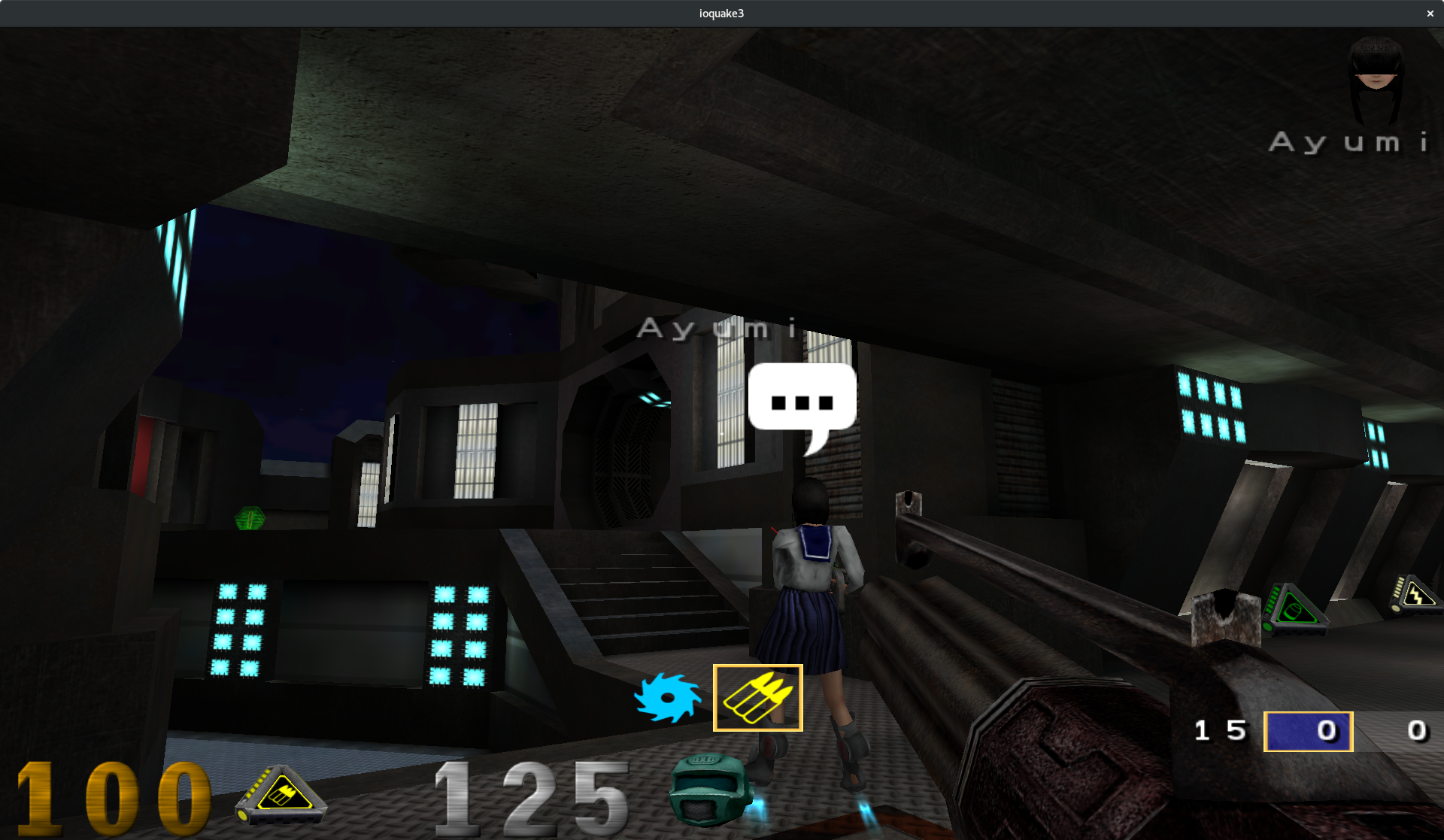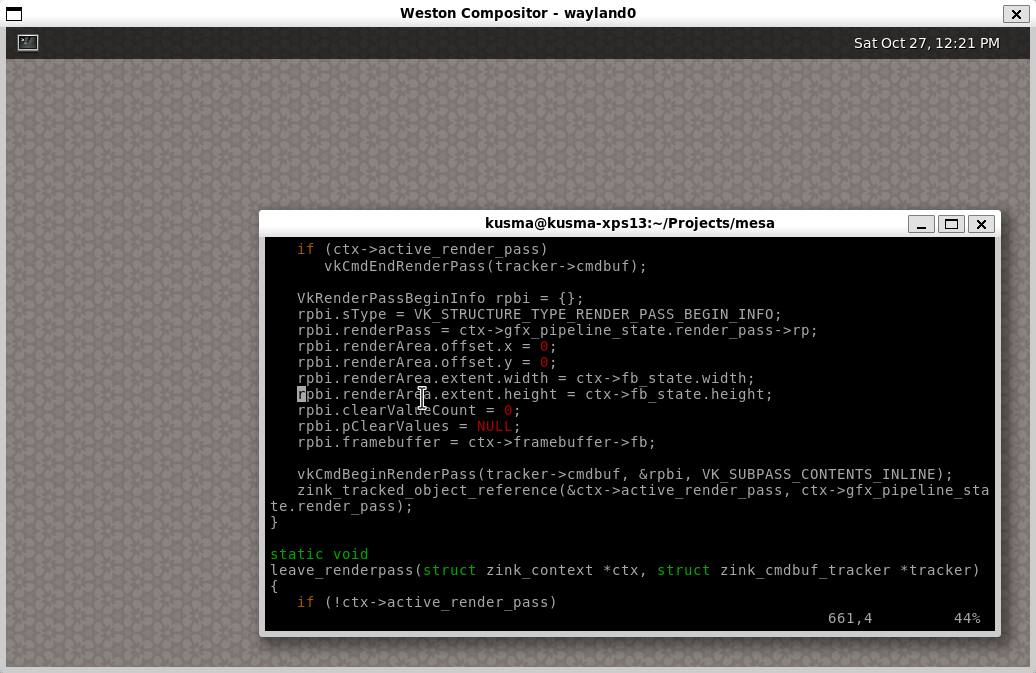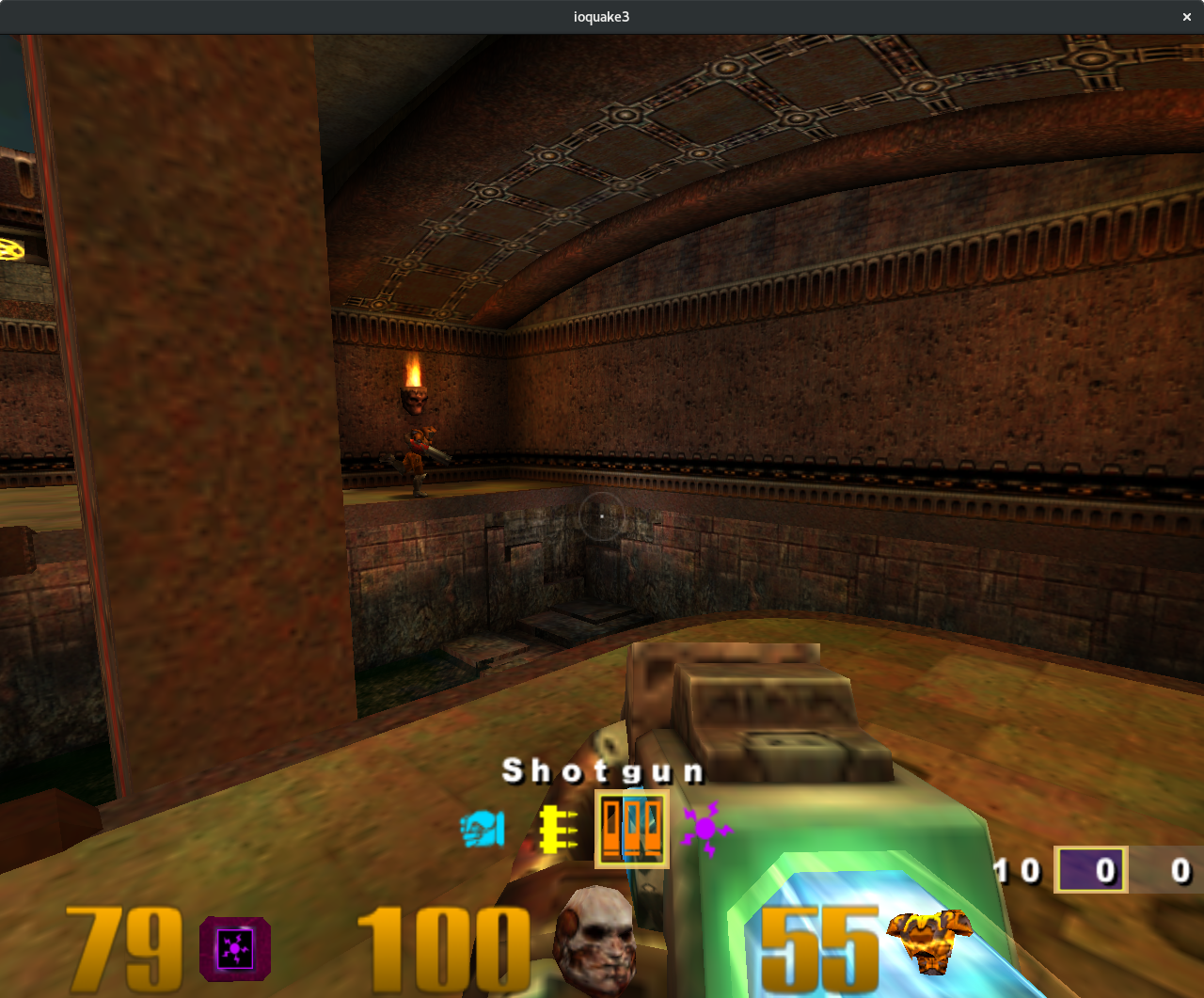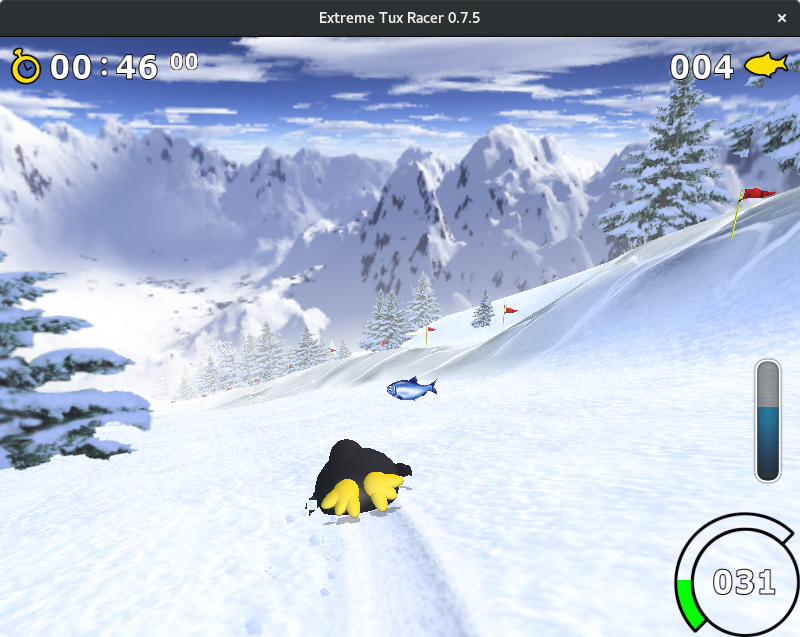Introducing Zink: OpenGL on Vulkan
For the last month or so, I’ve been playing with a new project during my work at Collabora, and as I’ve already briefly talked about at XDC 2018, it’s about time to talk about it to a wider audience.
What is Zink?
Zink is an OpenGL implementation on top of Vulkan. Or to be a bit more specific, Zink is a Mesa Gallium driver that leverage the existing OpenGL implementation in Mesa to provide hardware accelerated OpenGL when only a Vulkan driver is available.

Here’s an overview of how this fits into the Mesa architecture, for those unfamiliar with it:

Why implement OpenGL on top of Vulkan?
There’s several motivation behind this project, but let’s list a few:
- Simplify the graphics stack
- Lessen the work-load for future GPU drivers
- Enable more integration
- Support application porting to Vulkan
I’ll go through each of these points in more detail below.
But there’s another, less concrete reason; someone had to do this. I was waiting for someone else to do it before me, but nobody seemed to actually go ahead. At least as long as you don’t count solutions who only implement some variation of OpenGL ES (which in my opinion doesn’t solve the problem; we need full OpenGL for this to be really valuable).
1. Simplifying the graphics stack
One problem is that OpenGL is a big API with a lot of legacy stuff that has accumulated since its initial release in 1992. OpenGL is well-established as a requirement for applications and desktop compositors.
But since the very successful release of Vulkan, we now have two main-stream APIs for essentially the same hardware functionality.
It’s not looking like neither OpenGL nor Vulkan is going away, and the software-world is now hard at work implementing Vulkan support everywhere, which is great. But this leads to complexity. So my hope is that we can simplify things here, by only require things like desktop compositors to support one API down the road. We’re not there yet, though; not all hardware has a Vulkan-driver, and some older hardware can’t even support it. But at some point in the not too far future, we’ll probably get there.
This means there might be a future where OpenGL’s role could purely be one of legacy application compatibility. Perhaps Zink can help making that future a bit closer?
2. Lessen the work-load for future GPU drivers
The amount of drivers to maintain is only growing, and we want the amount of code to maintain for legacy hardware to be as little as possible. And since Vulkan is a requirement already, maybe we can get good enough performance through emulation?
Besides, in the Open Source world, there’s even new drivers being written for old hardware, and if the hardware is capable of supporting Vulkan, it could make sense to only support Vulkan “natively”, and do OpenGL through Zink.
It all comes down to the economics here. There aren’t infinite programmers out there that can maintain every GPU driver forever. But if we can make it easier and cheaper, maybe we can get better driver-support in the long run?
3. Enable more integration
Because Zink is implemented as a Gallium driver in Mesa, there’s some interesting side-benefits that comes “for free”. For instance, projects like Gallium Nine or Clover could in theory work on top of the i965 Vulkan driver through Zink. Please note that this hasn’t really been tested, though.
It should also be possible to run Zink on top of a closed-source Vulkan driver, and still get proper window system integration. Not that I promote the idea of using a closed-source Vulkan driver.
4. Support application porting to Vulkan
This might sound a bit strange, but it might be possible to extend Zink in ways where it can act as a cooperation-layer between OpenGL and Vulkan code in the same application.
The thing is, big CAD applications etc won’t realistically rewrite all of their rendering-code to Vulkan in a wave of a hand. So if they can for instance prototype some Vulkan-code inside an OpenGL application, it might be easier to figure out if Vulkan is worth it or not for them.
What does Zink require?
Zink currently requires a Vulkan 1.0 implementation, with the following extensions (there’s a few more, due to extensions requiring other extensions, but I’ve decided to omit those for simplicity):
VK_KHR_maintenance1: This is required for the viewport flipping. It’s also possible to do without this extension, and we have some experimental patches for that. I would certainly love to require as few extensions as possible.VK_KHR_external_memory_fd: This is required as a way of getting the rendered result on screen. This isn’t technically a hard requirement, as we also have a copy-based approach, but that’s almost unusably slow. And I’m not sure if we’ll bother keeping it around.
Zink has to my knowledge only been tested on Linux. I don’t think there’s any major reasons why it wouldn’t run on any other operating system supporting Vulkan, apart from the fact that some window-system integration code might have to be written.
What does Zink support?
Right now, it’s not super-impressive: we implement OpenGL 2.1, and OpenGL ES 1.1 and 2.0 plus some extensions. Please note that the list of extensions might depend on the Vulkan implementation backing this, as we forward capabilities from that.
The list of extensions is too long to include here in a sane way, but here’s a link to the output of glxinfo as of today on top of i965.
Here’s some screenshots of applications and games we’ve tested that renders more or less correctly:




What doesn’t work?
Yeah, so when I say OpenGL 2.1, I’m ignoring some features that we simply do not support yet:
glPointSize()is currently not supported. Writing togl_PointSizefrom the vertex shader does work. We need to write some code to plumb this through the vertex shader to make it work.- Texture borders are currently always black. This will also need some emulation code, due to Vulkan’s lack of arbitrary border-color support. Since a lot of hardware actually support this, perhaps we can introduce some extension to add it back to the API?
- No control-flow is supported in the shaders at the moment. This is just because of lacking implementation for those opcodes. It’s coming.
- No
GL_ALPHA_TESTsupport yet. There’s some support code in NIR for this, we just need to start using it. This will depend on control-flow, though. glShadeModel(GL_FLAT)isn’t supported yet. This isn’t particularly hard or anything, but we currently emit the SPIR-V before knowing the drawing-state. We should probably change this. Another alternative is to patch in a flat-decoration on the fly.- Different settings for
glPolygonMode(GL_FRONT, ...)andglPolygonMode(GL_BACK, ...). This one is tricky to do correct, at least if we want to support newer shader-stages like geometry and tessellation at the same time. It’s also hard to do performant, even without these shader-stages, as we need to draw these primitives in the same order as they were specified but with different primitive types. Luckily, Vulkan can do pretty fast geometry submission, so there might be some hope for some compromise-solution, at least. It might also be possible to combine stream-out and a geometry-shader or something here if we really end up caring about this use-case.
And most importantly, we are not a conformant OpenGL implementation. I’m not saying we will never be, but as it currently stands, we do not do conformance testing, and as such we neither submit conformance results to Khronos.
It’s also worth noting that at this point, we tend to care more about applications than theoretical use-cases and synthetic tests. That of course doesn’t mean we do not care about correctness at all, it just means that we have plenty of work ahead of us, and the work that gets us most real-world benefit tends to take precedence. If you think otherwise, please send some patches! 😉
What’s the performance-hit compared to a “native” OpenGL driver?
One thing should be very clear; a “native” OpenGL driver will always have a better performance-potential, simply because anything clever we do, they can do as well. So I don’t expect to beat any serious OpenGL drivers on performance any time soon.
But the performance loss is already kinda less than I feared, especially since we haven’t done anything particularly fancy with performance yet.
I don’t yet have any systematic benchmark-numbers, and we currently have some kinda stupid bottlenecks that should be very possible to solve. So I’m reluctant to spend much time on benchmarking until those are fixed. Let’s just say that I can play Quake 3 at tolerable frame rates right now ;)
But OK, I will say this: I currently get around 475 FPS on glxgears on top of Zink on my system. The i965 driver gives me around 1750 FPS. Don’t read too much into those results, though; glxgears isn’t a good benchmark. But for that particular workload, we’re about a quarter of the performance. As I said, I don’t think glxgears is a very good benchmark, but it’s the only thing somewhat reproducible that I’ve run so far, so it’s the only numbers I have. I’ll certainly be doing some proper benchmarking in the future.
In the end, I suspect that the pipeline-caching is going to be the big hot-spot. There’s a lot of state to hash, and finally compare once a hit has been found. We have some decent ideas on how to speed it up, but there’s probably going to be some point where we simply can’t get it any better.
But even then, perhaps we could introduce some OpenGL extension that allows an application to “freeze” the render-state into some objects, similar to Vertex Array Objects, and that way completely bypass this problem for applications willing to do a bit of support-code? The future will tell…
All in all, I’m not too worried about this yet. We’re still early in the project, and I don’t see any major, impenetrable walls.
How to use Zink
Zink is only available as source code at the moment. No distro-packages exits yet.
Requirements
In order to build Zink, you need the following:
Building
The code currently lives in the zink-branch in my Mesa fork.
The first thing you have to do, is to clone the repository and build the
zink-branch. Even though Mesa has an autotools build-system, Zink only
supports the Meson build-system. Remember to enable the zink gallium-driver
(-Dgallium-drivers=zink) when configuring the build.
Install the driver somewhere appropriate, and use the $MESA_LOADER_DRIVER_OVERRIDE
environment variable to force the zink-driver. From here you should be able
to run many OpenGL applications using Zink.
Here’s a rough recipe:
$ git clone https://gitlab.freedesktop.org/kusma/mesa.git mesa-zink Cloning into 'mesa-zink'... ... Checking out files: 100% (5982/5982), done. $ cd mesa-zink $ git checkout zink Branch 'zink' set up to track remote branch 'zink' from 'origin'. Switched to a new branch 'zink' $ meson --prefix=/tmp/zink -Dgallium-drivers=zink build-zink The Meson build system ... Found ninja-X.Y.Z at /usr/bin/ninja $ ninja -C build-zink install ninja: Entering directory `build-zink' ... installing /home/kusma/temp/mesa-zink/build-zink/src/gallium/targets/dri/libgallium_dri.so to /tmp/zink/lib64/dri/zink_dri.so $ LIBGL_DRIVERS_PATH=/tmp/zink/lib64/dri/ MESA_LOADER_DRIVER_OVERRIDE=zink glxgears -info GL_RENDERER = zink (Intel(R) UHD Graphics 620 (Kabylake GT2)) GL_VERSION = 2.1 Mesa 18.3.0-devel (git-395b12c2d7) GL_VENDOR = Collabora Ltd GL_EXTENSIONS = GL_ARB_multisample GL_EXT_abgr ...
Submitting patches
Currently, the development happens on #dri-devel on Freenode.
Ping me (my handle is kusma) with a link your branch, and I’ll take a look.
Where do we go from here?
Well, I think “forwards” is the only way to move 😉. I’m currently working 1-2 days per week on this at Collabora, so things will keep moving forward on my end. In addition, Dave Airlie seems to have a high momentum at the moment also. He has a work-in-progress branch that hints at GL 3.3 being around the corner!
I also don’t think there’s any fundamental reason why we shouldn’t be able to get to full OpenGL 4.6 eventually.
Besides the features, I also want to try to get this upstream in Mesa in some not-too-distant future. I think we’re already beyond the point where Zink is useful.
I also would like to point out that David Airlie of RedHat has contributed a lot of great patches, greatly advancing Zink from what it was before his help! At this point, he has implemented at least as many features as I have. So this is very much his accomplishment as well.